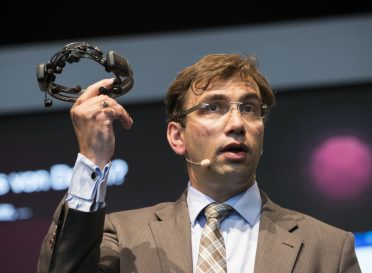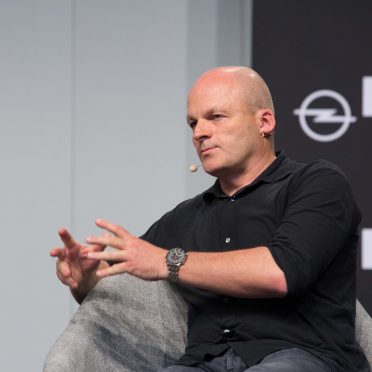
Dr. Lena Rittger Opel Project Director of Driver Performance EE Advanced Technology (center).
7 How to Not Drive Also Needs to Be Learned
“We teach cars to drive autonomously, but how do we communicate that to people?” Dr. Lena Rittger, Opel Project Director of Driver Performance Advanced Technology, addressed this question, stating that there are no easy or quick answers on this subject. But experience shows that
drivers quickly build up trust toward the vehicle and the assistance systems.
According to Rittger, Opel’s research is concerned with the communication between man and machine, and with the challenges that arise at this interface. What happens when the driver has to actively intervene all of a sudden while the car is semi-autonomously driving? Rittger believes that people are used to getting into the car and immediately taking over. Giving up control is something they will need to learn in a gradual process. Therefore, cooperation with driving schools will be crucial when introducing the new technology.
8
Whose Fault Is It When No One’s Behind the Wheel?
The debate surrounding autonomous driving is not only a technological and economic debate; it is also a question of ethics. Dr. Janina Loh, Technology Philosopher at the University of Vienna, researches trans- and post-humanism as well as robot ethics. She raised the following question: To what extent and how should autonomous systems be able to make decisions, and who bears the responsibility for wrong decisions? She argues that humans can give up control while driving, but not the responsibility for what happens. Even in the case of fully automatic driving, when a person cannot intervene at all in the case of an accident, humans still bear responsibility. After all, the vehicle owner bought the car and decided to use it that day.
Technology always has morals, whether you are building an algorithm, a hammer, or a machine gun. Therefore, for Loh, the gradual automation of driving does not mean “that we can transfer moral responsibility to machines.” Technology may always serve a man-made purpose, but machines cannot

Dr. Janina Loh Technology Philosopher, University of Vienna.
make situation-related decisions based on good common sense. Whether the machine gun shoots at someone, or whether it is ‘diverted from its intended purpose’ to pound a nail into the wall still depends on the person using it.

Sven Gábor Jánszky Futurologist and Head of 2b AHEAD ThinkTank.
9 The Reason Why Mobility Will Become Nearly Free
The way Sven Jánszky, Trend Researcher and Head of 2b Ahead ThinkTank, envisions the future, in 2027 driving will have become much cheaper or even free. Since autonomous cars no longer need to stand around doing nothing, but instead can ‘go to work,’ society will need fewer cars and therefore fewer parking spaces, which will particularly affect cities. At the moment, nearly one-third of a city’s space is allotted to parking. “One can assume that a handful of people will still drive their own cars, but the majority will rely on car sharing models,” asserts Jánszky.
In Jánszky’s opinion, public transportation along predetermined routes will thus become obsolete in the years to come. Studies assume that there will be shuttle buses that bring passengers to their desired destinations (similar to Uber). The cost of driving from A to B will approach zero if providers apply the ‘Google’ logic and use advertising as a source of income. Technology entrepreneurs and car manufacturers are already planning steps in this direction. According to Jánszky, it will still take several years before autonomous cars will be allowed on the streets, and another few years before this will become the new mainstream mode of transportation.

In the final discussion panel, ‘The Living Room on the Fast Lane: The Future Look of Automobiles and How It Will Impact Passengers,’ Opel’s Director Advanced Designer Friedhelm Engler (second from the left), Professor Lutz Fügener (third from the left) from Hochschule Pforzheim, and Alexander Mankowsky (right) from Futures Studies & Ideation Daimler discussed what cars of the future will look like, and what that will mean for passengers.
10 “Design Remains Key Discipline”
With autonomous transportation, there is a shift from ‘driving from A to B’ to ‘living in the vehicle.’ According to Lutz Fügener, Professor at Hochschule Pforzheim, an altered interior design will be at the heart of this fundamental transformation. Even more so, “The concept and the aesthetics of autonomous vehicles will have a significant impact on how well customers accept this new mode of transportation.” This leads to the question of what consumers actually want. “In my experience, it’s clear, minimalistic shapes rather than crazy ideas.” In this context, Mr. Fügener is highly intrigued by young students’ take on the automobile: “They do not feel awkward if they, as car designers, do not own a car themselves,” he explains. This choice is mainly driven by the practical consideration that, in a metropolis, public transportation is fully adequate for young people.

Lutz Fügener Professor at Hochschule Pforzheim, Transportation Design.

Alexander Mankowsky Futures Studies & Ideation, Daimler.
11Mobile Living Room – Cars Transform into a New Living Space
Alexander Mankowsky, Futures Studies & Ideation at Daimler, took a fascinating look at what ‘living in the vehicle’ may look like once autonomous driving becomes commonplace. “There will be numerous options and opportunities for how to use your vehicle if you no longer have to drive yourself,” the Futurologist postulates. “One person may turn the interior into a living room, while another may use it for yoga exercises on the way to work – and yet others will transform their vehicle into an office.” This last scenario represents a complete disassociation of what driving from A to B used to imply: “Here, the car becomes a so-called third place,” explains Mankowsky. This turns the car into a new space between home and the workplace. Mobile services may also develop, adds the Futurologist, showing a slide that visualizes this concept: autonomous cars, neatly lined up, that have been turned into vending platforms for potatoes, herbs, and tomatoes.
Mankowsky is certain of one thing: Autonomous driving will make the ‘normal ride’ as we know it today obsolete. More to the point, as the prerequisites of driving shift, taking a ride may very well become a leisure activity. In the words of Mankowsky, “Driving a car will become a hobby, a joyride people will do on the weekend.”

Friedhelm Engler Director Advanced Design, Opel.
12 Key to the Future of Mobility: A Vehicle Design to Fall in Love With
In the present day and age, cars represent individual mobility and are physical expressions of personal style, passion, and status. Their design has always aimed to arouse desire. But how do these parameters change if the car drives
autonomously? “The design of autonomous vehicles must emphasize yet another emotion: trust,” explains Opel Head Designer Friedhelm Engler. Engler going on to say that, given this challenge, designers take on a new, highly exciting role.
This is because the technological revolutions call for a “fundamentally different way of thinking” on many levels. For instance, the electrification of vehicles creates new room for creative design, because the battery can be put nearly anywhere in the car. “The current method of planning a car’s design from the outside and then moving inward will not hold up much longer.”
In light of each of these big changes, the Opel Head Designer advises to include the customer in each step of this journey: “I am confident that people’s love of cars will be the key to a successful transition to the future of mobility.”
Stand August 2017